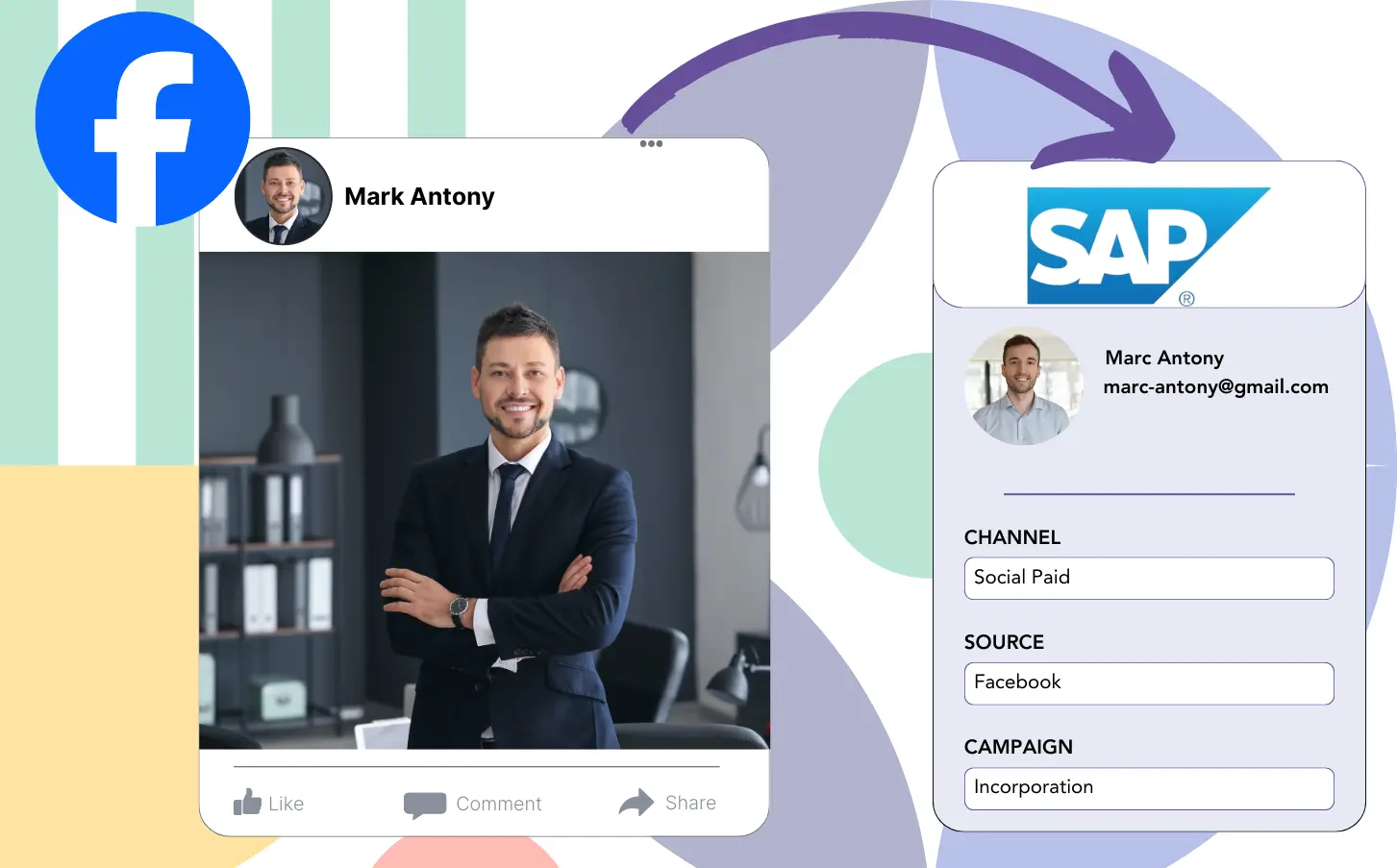Although you run lead generation ads on Facebook and route the leads to SAP, it is difficult to determine which specific ad generated each lead, preventing you from knowing which ad led to a sale after conversion.
The lack of this information prevents you from improving your Facebook ad performance, as you are running several ads at once without clarity on which one is producing results.
By connecting each lead to its respective Facebook ad, Leadsource provides visibility into the campaign, ad set, audience, and specific ad responsible for generating the lead.
In this article, you will learn how to assign each lead to the correct Facebook ad, campaign, ad set, and audience.
Let’s dive in!
Capture Facebook ads in SAP
Step 1: Add Leadsources in the head tag of your website
Sign up to Leadsources.io, and benefit from our 14-day free trial.
Add the Leadsources tracking code in the head tag of your site – follow this easy step-by-step guide.
Step 2: Add the UTM parameters to your Facebook ads campaigns
Include the UTM parameters you’d like to monitor in your Facebook campaigns.
For instance, these UTM parameters allow you to track the campaign, ad set, audience, and ad:
- UTM_source=facebook
- UTM_campaign=campaign-name
- UTM_term=ad-set-name
- UTM_content=ad-name
Leadsources collects detailed lead source information such as channel, landing page, and subfolder even without UTM parameters, ensuring comprehensive insights for each lead.
Step 3: Add the hidden fields in your form
To facilitate the storage of lead source data by Leadsources, it is necessary to add hidden fields to the form on your landing page.
Upon submission of your form by a new lead, Leadsources automatically populates the hidden fields with information from the Facebook ads.
Consult our guide for instructions on how to add hidden fields to your form to finalize the setup.
Step 4: Capture the Facebook ads data in SAP
When users click on your Facebook ads and reach your page, Leadsources collects the associated Facebook ads data, such as campaign, ad, ad set, and audience.
The hidden fields of your form are automatically filled with Facebook ads data by Leadsources.
After the form submission, the Facebook ads data and your leads can be automatically sent to SAP. To do this, just connect your form to SAP.
How does Leadsources work?
Adding the Leadsources tracking code to the head tag of your website allows it to gather Facebook ads data, such as campaign, ad set, audience, and ad whenever a visitor lands on your page.
After the Facebook ads data is captured, it is saved in the hidden fields of your form, and this information can then be forwarded to your SAP with the lead.
The following information is gathered by Leadsources from visitors:
- Channel
- Source
- Campaign
- Content
- Term
- Landing page
- Landing page subfolder
Even without UTM parameters, Leadsources monitors this lead source data effectively.
Certain situations may prevent you from utilizing UTM parameters:
- Google Search
- Instagram bio link
- Social media posts
- Etc.
Many lead source tracking tools face difficulties because they depend entirely on UTM parameters for lead source data. In contrast, Leadsources can still track the lead source data even when UTM parameters are absent:
- Channel
- Source
- Landing page
- Landing page subfolder
Consequently, Leadsources enables lead data tracking across various channels, setting it apart from competing tools:
- Organic Search
- Paid Search
- Organic Social
- Paid Social
- Referral
- Affiliate
- Display Advertising
- Direct Traffic
By categorizing your traffic by channel, Leadsources ensures that your dataset remains organized and clean.
Leadsources allows you to set up robust lead source tracking across every channel in one central location.
How to run performance reports
Now that Facebook ads data is tracked in SAP, you can generate multiple performance reports, such as:
- Leads by channel
- Leads by campaign
- Leads by ad set
- Leads by audience
- Leads by ad
- Leads by landing page
- Leads by landing page subfolder
As a result, you can analyze and readjust your Facebook ads budget with accuracy.
Let’s review the various reports that you can create.
Lead performance reports
These reports indicate the quantity of leads produced by:
- Channel
- Campaign
- Ad set
- Audience
- Ad
- Landing page
- Landing page subfolder
Example #1
Generate a report titled “Leads by Channel” by exporting data from different channels such as SEO, PPC, and email.
Example #2
Upon determining the most effective channel, like Facebook ads, you can direct your attention to it and examine the number of leads produced by each campaign.
Example #3
Identifying the most successful lead-generating campaign allows you to determine which audience, ad set, or ad is contributing to those leads.
Sales performance report
Recognizing the ads and keywords that produce the highest number of leads is valuable, but do they also play a role in your revenue generation?
Transferring your form data to SAP allows for the creation of detailed sales performance reports.
Example:
| Channels | Search Paid | Social Paid |
| Leads | 50 | 75 |
| Sales | 5 | 6 |
| Average order value | $150 | $100 |
| Revenue | $750 | $600 |
Upon analyzing the performance of your Google and Facebook ads, you found that Social Paid ads yielded a greater number of leads compared to Search Paid ads.
After several weeks of analysis, you discovered that the Search Paid channel generated higher revenue, despite producing fewer leads than the Social Paid channel. This made you to decide on a budget increase for the Search Paid campaigns.
LeadSources tracks the source of each lead in SAP, whether they come from ads, organic search, social, email, etc. and syncs that data with each submission. See the full breakdown on the lead source in SAP page.
